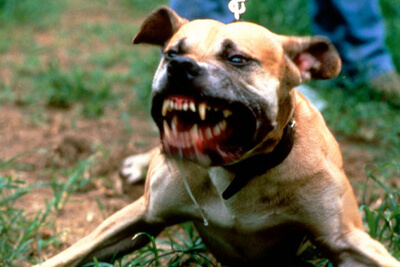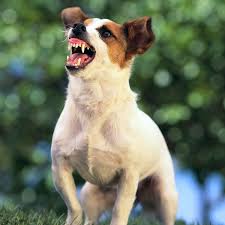Understanding the Dog Fight Flight Response
What is Dogs Fight Flight Response?
Fight flight: Dogfight or flight response, you may wonder what it means. No, it doesn't mean your dog will wear boxing gloves and fight on the ring nor does it mean he'll grow wings one day and will take off and fly. The fight flight response seen in dogs is an innate survival instinct you still see in humankind as well.
I will never forget the day our physics professor showed up in class and was starting a lecture on the fight and flight response in humans. He started talking to use very softly, so softly I felt like nodding off, when suddenly he took a book and with all the force of his biceps, he slammed it on the desk. We all startled and looked at each other wondering if our teacher had gone insane. Then he explained: "This, is the perfect example of an adrenaline rush that would stimulate you to engage in fight or flight."
By definition, the fight flight response is a physiological reaction (not under conscious control) that occurs when an animal or human feels threatened. It was first described by American psychologist Walter Cannon in 1920. This chain reaction causing a cascade of events is meant to help the body deal with threatening circumstances.It all starts with the amygdala which triggers activation of the pituitary gland causing a sudden release of catecholamines such as hormones and neurotransmitters such as cortisone, adrenaline, and noradrenaline. This causes a series of changes in the dog's body and mind that we will see in the next paragraph.
Great reads by James O' Heare
Training Dogs: A Dog Owner's Guide to the Science of Behavior and Non-coercive Dog Training
Physiological Changes Caused by Fight Flight in Dogs
The release of hormones and neurotransmitters during the fight or flight acute stress response causes a variety of physiological changes in the dog. These physiological changes are the body's effort to create a boost of energy sufficient to get the dog out of trouble and survive. While a brief, acute response to a suspected trigger may cause temporary physiological changes, the effects of chronic, prolonged stress in dogs can long term undermine the dog's immune system.
Following are some physiological changes seen in a fight flight response in dogs.
Increased blood flow to muscles (so the dog can sprint into action)
Increased muscle tension
Increased blood clotting (so to prevent excessive blood loss)
Appetite suppression (blood flow goes from skin and intestines to muscles for action)
Dilated pupils (so to see with more clarity)
Inability to concentrate, lack of impulse control, lowered threshold
According to Hans Selye, the body when stressed goes through a "General Adaptation Syndrome." After the initial activation alarm phase of fight flight, the body goes through a resistance phase, where homeostasis works on restoring balance and recovery. This is when the dog "shakes off" the stress so to relax those tight muscles, resumes normal breathing and his heart rate slows down.
The exhaustion phase is then seen if the stress is allowed to continue for some time and the resistance phase is repeated too often, and in this case, burnout occurs with its negative effects on the body. The dog's immune system is lowered, cognitive functions (ability to learn) are depleted, energy levels lower leading to lethargy and disrupted sleep patterns. Some dogs may have a hard time relaxing even when there's nothing happening. However, a dog that is acutely stressed may become hyperactive as a defense mechanism before later shutting down.
Choosing Fight over Flight: Special Circumstances
The choice of fight flight varies depending on the situation. For instance, a dog who just gave birth to puppies will choose to fight if the puppies are threatened by an animal rather than flee, leaving the vulnerable puppies at risk. Whereas, some dogs may normally flee when presented with a frightening stimulus, but may resort to fighting if their escape routes are blocked. Genetic predispositions may also play a role. Some dogs breeds may be more likely to choose fight over flight and flight over fight. A learned component may be at play too. A dog who was predisposed to flee may decide to fight first if his attempts to flee were often unsuccessful in the past. This is the dog who stressed by children chasing him and cornering him decides to bite one day to make the chasing stop once and for all.
Other Options Beyond Fight or Flight in Dogs
Interestingly, when dogs are faced with a perceived threat, they don't necessarily go into fight or flight, they may also have a plan C, a plan D, and a plan E. Basically, the fight and flight response can be extended by adding the freeze, faint and fool around response.
In nature, we can see these "Five F" reactions in a variety of animals. A lion feeling threatened will often fight, a zebra feeling threatened may flee, a rabbit feeling threatened may freeze as if becoming almost invisible. The fainting goat is an example of an animal that truly faints when in a state of panic, even though this is not the greatest example as this is mostly caused by a hereditary genetic disorder.
In dogs, signs of a fight are pretty evident. The dog may lunge forward, bark and attempt to bite. The signs of flight are also quite evident, the dog may cower behind the owner if leashed or attempt to flee to get out of trouble. During the freeze, the dog may stand still, hold its breath and have a fixed look in his eyes. Be careful as a bite may come next. Real fainting is quite rare, but it can be seen when a dog drops to the ground and refuses to budge. Most likely it's a sign of learned helplessness.
The fool around response may sound harmless but it's, in reality, a sort of displacement behavior; basically, the dog is taking off the steam from a stressful situation by engaging in a totally different behavior such as rolling on the floor, catering to a sudden itch or humping anything in sight. These are not signs of a disobedient dog who is acting out, but signs that the dog is stressed.
So pay attention to your dog, and try to recognize triggers that may cause the fight or flight response. Prevent these triggers from affecting your dog, and if possible, try help your dog face irrational fears through desensitization and counterconditioning.

